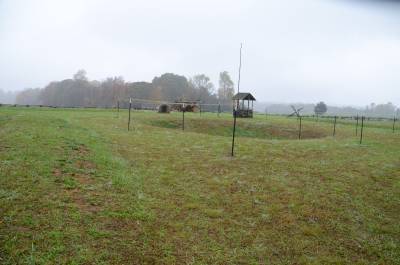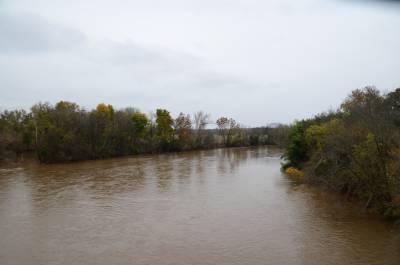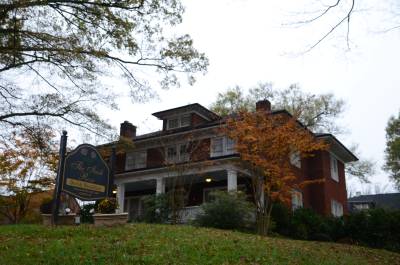Ghosts and murders
I had to say goodbye to Jim and Kathy. The plane delay meant that I would only spend one night with them before moving on. When I got up it had stopped raining, so I walked down to the creek to take some pictures before having breakfast. Both Jim and Kathy tried to talk me into coming back the same night, but I had already arranged for another place to stay, so even if the offer was nice, I had to decline. This was going to be a "sightseeing only" day, and ghosts and murders was to be the main attractions. As mentioned on the Tour de Macabre front page, I had brought a couple of books with me, Death in North Carolina's Piedmont and Ghosts of the North Carolina Piedmont and those were going to guide me to most, but not all of this days visits.
Moravian Falls

The bottom of Moravian falls, and a fish spotting heron
My first goal was not scary though. When I left Stoney Fork I headed for Wilkesboro, and from there around 4 miles south to the small village Moravian Falls. Not to see the village, but to see the falls, that had lent it's name to the settlement. I found it easily enough - I had passed through on earlier vacations without seeing the falls, but now it was time, and neither did I have any troubles finding them. At the foot of the falls a heron was busy spotting fish, but it didn't catch any while I was there. I got some photos though, of both the falls, the heron and also the Moravian Creek, that makes the falls. Wikipedia claims that the falls are a local tourist attraction, and that may very well be the case, at least it attracted me. I was the only one there though, so I don't know how big an attraction it actually is.
At this point it was still dry, but as soon as I walked back to my car and made ready to continue, it started to rain. In the beginning just a drizzle, but later it rained more and more. All day it changed between heavy rain and drizzling.
The ghost train
Next stop was planned to be at Bostian Bridge outside Statesville in Iredell County. I drove to Statesville and from there it was rather easy to find. The day before I had visited the site of The wreck of the Old 97 in Danville, Virginia and this is the site of another train wreck. Actually the worst catastrophy in the history of Iredell County, but as far as I know, no songs have been written about it. Bostian Bridge, named after a widow who owned the land when the bridge was build is a railway bridge that carries the railway tracks over Third Creek about two miles west of the railway station in Statesville. On August 27th 1891, early in the morning, a passenger train from Western North Carolina Railroad left Statesville for Asheville. When it reached Bostian Bridge just outside town, the train was derailed at a speed of 40 miles per hour, and it fell 60 feet to the bottom of the gorge. At least 20 people were killed, and some died later of their wounds. Among those killed were the engineer, William West, and baggage master Hugh K. Linster, who had just recieved a gold pocket watch for 30 years of service. It was later proven that the accident was caused by some of the spikes, holding the rails having been removed. Six years later two men were convicted for the crime.
Since then a lot of people claims to have heard and/or seen the train crash on the same night (between August 26th and 27th) and some even have met baggage master Linster looking at his gold watch and asking for the time, and when they turned he had disappeared. Even today the bridge causes accidents. As late as in 2010 a young man had gone to watch the ghost train on this particular August night with some friends. He walked out on the bridge to get a better look, only to be hit by a train that was all too real, and not just a ghostly image.
It was rather easy to locate the bridge - or rather a place, from where I could see the bridge. I parked my car, took some pictures but didn't see any ghosts whatsoever. But OK, it wasn't August, and it wasn't past midnight, so what could I expect? Instead I turned down a poor familiy that asked me for directions to somewhere, but with my very limited knowledge of the area I unfortunately wasn't able to help them. With my visit here complete, I returned to Statesville. I remembered, that even if I had been in town three or four times, the only pictures I had was of the old railway depot and one of the places where Tom Dooley may have been hanged. I decided to do something about that, so I drove to one of the other places that I suspect might have been the place of execution. During my visit in 2004 the Old Railway Depot served as a Visitor Information Center, but in 2012 it had become home of the Statesville Housing Authorities. They told me though, where I could find the visitor infomation center, but unfortunately I had forgotten. So I decided to go there again. When I got there, I was a little surprised to see more than 50 police cars outside the place, but I soon discovered that it was now the headquarters of Statesville Police Patrol Division, which explained the police's presence. Fortunately a police officer was outside, so I asked him where to find the information center, which he explained.
When I had arrived in Stateville it had started raining again, but now I wanted to have some pictures, so I drove to the center of town and parked the car. I walked to the information center, only to find it closed. Instead I walked a little around town in the rain and took a few pictures, before returning to the car.
Fort Dobbs

What's left of Fort Dobbs.
On my way to Bostian Bridge I had seen a sign for Fort Dobbs. I didnt know what that was, but decided to go there anyway. It might be interesting. I found the place without difficulties only to find the place closed. Or at least the small visitor center was. The area itself was open to visitors, so I took a stroll around the site, while the rain was getting heavier again. From an information sign I learned something about the place though. It was constructed in connection with the French and Indian Wars in the 1750's, and it had only seen action once, in 1760 when the place was attacked by a small band of cherokee indians. At that time the whole fort consisted of a log cabin with a deep cellar surrounded by a palisade. The fort was named after Arthur Dobbs, governor of North Carolina at the time of the building. After the war the fort was left to itself, and gradually it decayed until it was finally torn down, and the area used for farming.
In 1909 the then owner of the land donated a large tract to Daughters of the American Revoulution. The organization later bought more land and in the 1960's archeological excavations began in the area and the actual site of the fort was found in 2006. All that is left is a hole in the ground where the log cabin stood, and an old well. Even so I walked around the area for about half an hour getting more and more wet, before finally returning to my car.
War and more unseen ghosts

Yadkin River near Shallow Ford
This time I programmed my gps to take me to my next goal, and it lead me north on I-40, our favorite interstate. 25 miles later I left the interstate again and on smaller roads I continued through fields and wooded areas to whats left of Huntsville, the first town established in Yadkin County. Today Huntsville is part of Yadkinville. That was not my goal though. My goal was Shallow Ford, a shallow ford across the Yadkin River. Also here I found a place to park my car and walked to a modern bridge crossing the river, from where I had a view of the old ford.
Along the roadside were two Historical Markers. One told of a battle between tories and whigs during the revolution, and the same also told that Lord Cornwallis crossed the ford with his army later in the American Revolution. The other one told of how there had been a skirmish between union and confederate troops at the ford during Stoneman's Raid. I took pictures of the markers, the river, the ford, the woods and so on. What I really had come to see was yet another ghost, but I didn't see this one either. Some reports tell of a partly transparent man dressed in a revolutionary war officer uniform riding towards the ford only to disappear. Some think it's a colonel Lanier who is trying to escape the British after his plantation had been occupied by Cornwallis and his troops. Others think that it is Colonel Laniers slave who is trying to lead the pursuers astray to give his master time to hide. No matter who it was, no ghost was present during my visit, and neither when I returned a few days later.
Even more ghosts, and a few more murders
To get to my next stop I took a little detour, so from Shallow Ford I headed north on a small road called Dinkins-Bottom Road. A family by the name of Dinkins used to have their farm here. Not far from Shallow Ford this road crosses a small creek, and some say that it is at this bridge the ghost of Colonel Lanier can be seen. In the old days it was a small, one-lane wooden bridge, but it has long since been replaced by a modern day, two-lane paved bridge - and that may have scared the ghost away, or maybe I did, because I saw no ghost here either.
My goal was another small road called Speer Bridge Road, and to get there I drove a short stretch on US 421 until I got to Speer Bridge Road. This road has it's name from Henry Speer who built a bridge across Deep Creek in the mid seventeenhundreds. I wasn't particular interested in Henry Speer though, but rather in his son, Samuel. Unfortunately the house Samuel Speer lived in has been torn down within the last 10 or 15 years.
Samuel Speer was one nasty fellow. He was born in 1778 and in 1812 when he was 34 years old, he married a widow. They had four or five children together, among those a daughter called Jane. In 1847 Sam's wife died after 35 years of marriage and the next year, he, now 70 years old, married a 42 year younger woman. Seven years later the second wife filed for divorce. The reason she gave was that all the way through the marriage Samuel had been violent and abused her. He also had begun a sexual relationship with a woman called Caroline Dinkin. The two families lived only about 1,5 miles from each other, and Samuel had started cheating om his wife less than a year after the marriage. When she confronted him, he threatened her with a knife, so she had to escape to a neighbor, where she stayed for the next four months. A couple of years later she got ill, and he threatened to kill her, if she didn't leave the house, so she did, and she settled with her sister. A year after this, still living with her sister, she filed for divorce. Samuel was at that time 77 years old, but he hadn't softened with age. Also in other areas he was still going strong. Around the same time his wife filed for divorce he had a child with his mistress. Now the two of them and the child moved to Texas with Jane, his daughter from the first marriage and her husband and children. Samuel and his wife was never divorced though and some years later he returned to Yadkin County - apparently without his mistress and daughter. He and his wife never moved in together again, but lived only about a mile from each other. He was now 82 and she was 40! The story doesn't mention any further conflicts between man and wife, but that doesn't mean there weren't any. Samuel Speer died in 1868 in the advanced age of 90, and now he is or maybe was haunting the place. Some say that he regretted his behaviour and now is making amends to his wife, while others think that he is haunting the place to hurt her even more. He hasn't been seen for a while, and maybe now his house is gone, he has no place to haunt.
Only a few hundred yards from the Speer's place was another small cabin. In 1947 it was occupied by family consisting of mom, dad and three daughters. On january 30th something made the father break down mentally. Suddenly he yelled to his wife: "Jesus says it's time to go". Then he grabbed the three daughters, threw them in the well and jumped after them. When the wife asked if he was injured or if he was able to climb back out by himself, he replied: "When the Lord calls me, I will get out, not before". The Lord must have called because soon after he climbed from the well with the help of his wife. Using a neighbors telephone the sheriff was called, but when he arrived with a rescue team, the three girls were already dead. The fathers only defense was: "I must have been insane". In court he was declared insane and he was sentenced to life imprisonment in a mental hospital.
14 years later, in 1961, another family lived in the same cabin. The father was a moonshiner who loved his own products. One day after a night of heavy night his wife confronted him, wanting him to stop drinking. In response he took his shotgun and shot his wife. When his two kids came running he told them, that he would do the same to himself and left the house with the shotgun, some shells and a jar of moonshine. The children called for help and the sheriff arrived with dogs. They started searching the woods, and when the husband heard the dogs he tried to shoot himself, but only wounded his shoulder. Less than two weeks later he confessed in court and was sentenced to life imprisonment.
A very macabre afternoon so far, and it was not yet over.
Dobbins Mill Pond - murder, accidents and maybe ghosts
The final place to visit was a mill pond around 3 miles north of Yadkinville and 10 miles from Speer Bridge Road by the fastest route. I took another one though. It was a bit shorter but took more time. I found the mill pond and it looked very beautiful even on a cloudy day. The water was quiet and the trees reflected in the surface.

Dobbins Mill Pond
So what drama has happened here? Well quite a few people has drowned in the pond. In winters so cold, that the lake freezes, it is used for ice skating by locals. In the fifties a six year old girls drowned when she fell through thin ice, and several others had fallen through the ice but luckily most were saved. In summer the lake is used for swimming, fishing, boating and so on. But even if it looks quiet and calm, the lake is insidious. It has an average depth of around 10-12 feet, but with much deeper holes, where the water is several degrees colder than the rest of the lake. Also in some places there is a strong current, especially where the lake drains into a creek. In 1947 a good swimmer was swimming in the lake with his friends, when he suddenly disappeared beneath the surface never to come up again. Even with help from people in boats and on shore, his friends couldn't find him. Not until several hours later, when his body was discovered at a place far from where he went down. Local lore tells, that on nights after a drowning, you can see mysterious lights moving across the surface of the lake.
The lake was made by Jesse Dobbins who built a mill here after the civil war, and wanted to secure the water supply for this mill. Dobbins was not a popular man in the neighborhood. he had fought for the union during the war, and before that he had probably shot a militia captain, coming to arrest him as a deserter from the confederate army. After the war he was still wanted for this murder, but when the sheriff tried to arrest him he escaped to the nearest union garrison. Some days later he returned with a union colonel and some troops that demanded that all papers about the case should be destroyed and all charges against Dobbins should be dropped. That didn't make him any more popular with the locals. When Abraham Lincoln was murdered, Dobbins established a local division of The Republican Party. This was not too wise in an area where everybody else where Democrates. A few years later Dobbins was found dead at his mill, and most agreed that he had been killed by Democrats, or by a confederate veteran.
Dobbins presence is from time to time felt if not seen on the banks of his mill pond. Some believes that he can't find peace because he died with an unconfessed murder on his conscience, while other believe that he wants to be cleared of the unjust murder charge. I neither felt nor saw any presence, nor did I see any mysterious lights, but the pond was rather pretty, and I took some pictures.
And now on to The Irish Rose
 The
Irish Rose B & B in Lenoir
The
Irish Rose B & B in Lenoir
From Dobbins Mill Pond I headed for Hickory to pick up the book I had reserved the previous day. Once more I used I-40 to get there. I got my book and set the course for Lenoir. Along the way I discovered that I had nothing with the address of the B&B, so I called my son back home in Denmark and asked him to look it up on the internet, which he did. When I had the address, locating the place was easy enough, but I had some trouble finding a place to park my car. I finally left it in a parking lot belonging to a furniture company. The next challenge was to find the right entrance to the house, but finally I managed that as well. I was greeted by Rose, who told me, that I could park behind the house, so I went back to the parking lot and picked up the car. Inside we took care of the paperwork, and then Rose showed me around her beautiful house, and of course also my rather large room, with an impressive 300 square feet bathroom.
I carried my suitcase and bag to the room, and unpacked a bit. Then I returned downstairs to the kitchen. Here Rose told me about the breakfast procedures, and I ordered the breakfast for next morning, including something called a "german pancake", I didn't know what that was, but it sounded nice. For the next two hours I chatted with Rose. I was the only lodger that day, but that was the only one. Along the way Rose showed me the refrigerators with free soft drinks, water, beer and so on, and where to make coffee. I also said hello to her 13 weeks old, very charming Cavalier King Charles Spaniel, puppy called Finnegan. It was the Irish Rose after all, even if Rose herself was from Canada.
After a couple of hours talk I decided to get some supper, so I drove to the nearest Ruby Tuesday, where I had salat and chicken. I had still not become very hungry after the full breakfast at Jim and Kathy's place. Back at The Rose, I went to my room to write some mails and read a bit in my books before bedtime. Even though I didn't spent much time on freeways today I actually met a lot of countable trucks, so after todays excursion the score was
| Swift Transportation | 12 |
| J. B. Hunt Transport Services | 11 |
| Knight Transportation | 5 |
| Werner Enterprises | 5 |
| C. R. England Inc. | 3 |
| Schneider National | 1 |
-
Return to Tour de Macabre
-
-
Return to Travel Stories -